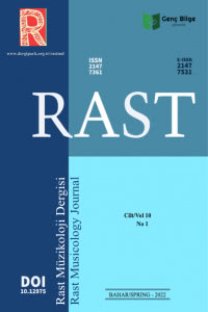K-Pop erkek idol gruplarındaki müzikal değişimlerin karşılaştırmalı analizi
K-Pop, idol, hallyu, vokal analizi, Kore dalgası
A comparative analysis of musical changes in K-Pop male idol groups
K-Pop, idol, hallyu, vocal analysis, Korea wave,
___
- Billboard Korea (2020). Rap-Singing, an innovative combination of singing and rapping, the golden age of rap-singing. Billboard Korea. http://billboard.co.kr/main/news/view/415
- Choi, S., & Seongjun, L. (2019). The Third-generation K-pop Idols’ Strategies: Focused on EXO, TWICE and BTS. Journal of the Industrial Innovation Research, 35, 62.
- Choi, S., Jung, J., and jung, S. (2016). Concept and Procedures of Qualitative Content Analysis, Journal of Qualitative Inquiry, 2(1), 132.
- Downe-Wamboldt, B. (1992). Content analysis: Method, applications and issues. Health Care for Women International, 13(3), 313-321.
- K-Pop Gallery. (2021). The shocking trick Olivia’s enthusiastic fans are now using to bring down bulletproofs. Youtube. https://youtu.be/bMDoMpH_Wm4
- Kim, A. (2018). The List. Shinhwa listed in the Guinness Book of World Records for the longest-running idol group. Herald Pop. http://pop.heraldcorp.com/view.php?ud=201802270035112767165_1
- Kim, D. (2021). NCT, ‘great people’ armed with talent and charm. Today News. http://www.ntoday.co.kr/news/articleView.html?idxno=79027
- Kim, G. (2015). The Study for Idol Music as New Korean Wave and Ecosystem Equilibrium of Korean Popular Music Market 2000-2014. Journal of the Korea Contents Association, 15, 159.
- Kim, G., Lee, S., and Yoo, J. (2019). 2019 Foreign Contents Market Analysis. Seoul: Korea Creative Content Agency.
- Kim, G., Lee, S., and Yoo, J. (2020). 2020 Foreign Contents Market Analysis. Seoul: Korea Creative Content Agency.
- Kim, Y. (2020). Global Hallyu Trends 2020. Seoul: Korean Foundation for International Cultural Exchange (KOFICE).
- Kim, Y. (2021). Archive K BTS Entering the Billboard charts is really scary, and it’s all thanks to Army. Osen. https://n.news.naver.com/entertain/article/109/0004368814
- Korean Entertainment And Sports Newspaper. (2021). Hip-hop, which used to be a subculture, is now developing into a popular culture. Korean Entertainment And Sports Newspaper. https://url.kr/9iewo2
- Korean Foundation for International Cultural Exchange (KOFICE). (2017). Hallyu White Paper, 112.
- Kwak, H. (2018). EXO’s 5th album ranked No. 1 in the album charts for 3 weeks in a row without a break. Sports Donga. https://sports.donga.com/3/all/20181119/92926790/1
- Lee, G. (2016). The Era of K-pop. Paju: Hanul Academy.
- Lee, G. (2020a). K-pop in conflict. Seoul: Three Chairs Publishing.
- Lee, G. (2020b). The three secrets to the K-pop craze are music videos, perfect dance, Korean lyrics. Chosun Ilbo. https://www.chosun.com/site/data/html_dir/2020/06/10/2020061000007.html
- Limb, S. (2013). What Makes K-Pop So Successful?, Korean Business Review, 17(2), 328-344.
- Min, G. (2018). K-pop makers. Seoul: Book Nomad.
- National Institute of Korean Language. (2002). Urimalsaem. Open Dictionary. https://opendict.korean.go.kr/dictionary/view?sense_no=735222&viewType=confirm
- National Institute of Korean Language. (2010). Urimalsaem. Open Dictionary. https://opendict.korean.go.kr/dictionary/view?sense_no=1373922&viewType=confirm
- National Institute of Korean Language. 2016. Urimalsaem. Open Dictionary. https://opendict.korean.go.kr/dictionary/view?sense_no=629992&viewType=confirm
- News Claim. (2021). A 10-year history of Korean hip-hop through ‘Show Me the Money 10’. News Claim. https://url.kr/oeygfx
- Park, S. (2019). Cross-cultural sensitivity, a virtue for new Hallyu. N Content, 13, 20–3.
- Park, Y. (2011). Super Junior to be the first in the world to be ranked No. 1 in Taiwan’s charts for a year with Bonamana. Star News. https://star.mt.co.kr/stview.php? no=2011053108431457939&type=1&outlink=1
- The Tonight Show Starring Jimmy Fallon. (2021). BTS Dishes on Touring and Working with Ed Sheeran. https://youtu.be/ff6zBfAmX58
- Yang, K. (2017). K-POP Trend Analysis Using Melon.com Chart Data, The e-Business Association, 18(3), 15-16.
- ISSN: 2147-7361
- Yayın Aralığı: Yılda 4 Sayı
- Başlangıç: 2013
- Yayıncı: Genç Bilge Yayıncılık (Young Wise)
Türkiye popüler müziğinin salt müziksel eğilimleri 2007-2017
Onur KARABİBER, Songül KARAHASANOĞLU, Elif YAVUZ
Expressive piano technic: basics of healthy movement, technic and interpretation
Yeni kaynaklar ışığında yeni bir Rauf Yekta Bey biyografisi
Duygu TAŞDELEN, Nilgün DOĞRUSÖZ DİŞİAÇIK
Teaching pop vocal performance to students: A comparison of methods used in Russia
Natalia ANUFRİEVA, Semyon LİMANOV, Yana MAMONOVA, Natalia ANCHUTİNA, Maria Kats KATS
Kira MAİDENBERG-TODOROVA, Olena KHOROSHAVİNA, Inna HODİNA, Olga VORONOVSKAYA
İlkokul düzeyinde etkin müzik öğretim yöntemlerinin analizi: Rusya örneği
Marina PEREVERZEVA, Natalia ANUFRİEVA, Anna SHCHERBAKOVA, Elena KUZNETSOVA, Alena ZHARKOVA
Azerbaycan folklor türlerinden olan “meyhana”nin diğer halaklarin müzik türleriyle benzer yönleri
Nevbet-i Müretteb’in farklı coğrafyalardaki izleri üzerine bir inceleme
Ali İhsan ALEMLİ, Nilgün DOĞRUSÖZ DİŞİAÇIK
Emotional expressiveness of the vocalist: a cross-sectional study
Alina SHPYRKA, Larysa BONDARENKO, Ganna KONDRATENKO, Alexandr SHPYRKA
Kateryna NEMCHENKO, Larisa LOBODA, Anatoliy NOSULYA, Olena KUCHMA
